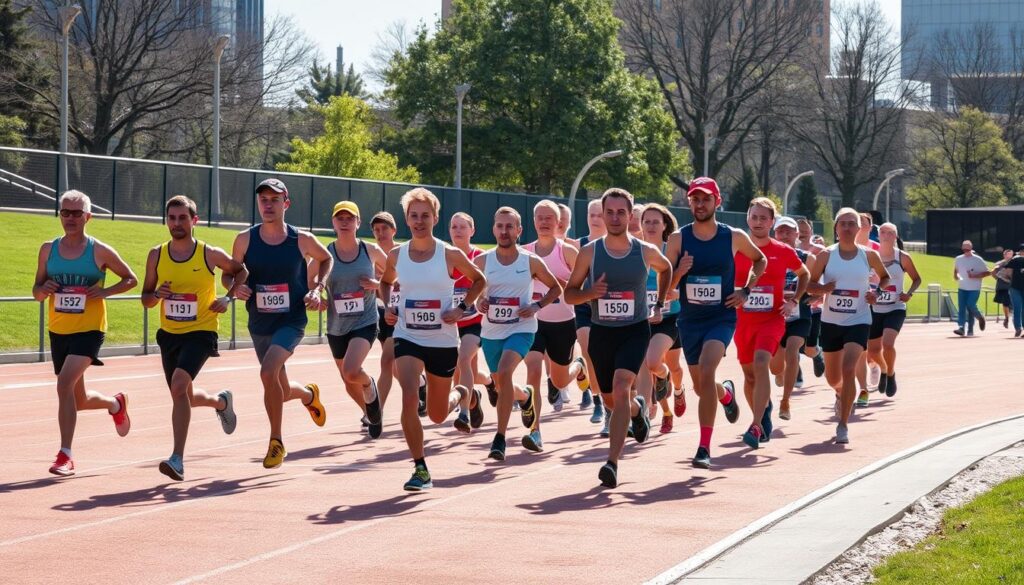If you want to lose weight and look leaner, running might be what you need. Over 64 million people in the U.S. run to burn fat and lose weight. Running burns 33-35 more calories per mile than walking. This means you can burn 330-350 extra calories over a 10-mile run.
Running also has more benefits for fat loss. A 155-pound person can burn 372 calories in 30 minutes of running at 6 miles per hour. Plus, running can keep burning calories for up to 48 hours after you stop.
Running helps you feel less hungry too. It lowers the hunger hormone and increases a hormone that makes you feel full. Also, running can target belly fat, even if you don’t change your diet.
Key Takeaways
- Running burns significantly more calories per mile compared to walking.
- High-intensity running can continue to burn calories for up to 48 hours after your workout.
- Running can help suppress appetite by lowering the hunger hormone ghrelin and increasing PYY production.
- Moderate-to-high intensity running is effective at targeting stubborn belly fat without dietary changes.
- Running offers numerous health benefits, including reduced risk of heart disease, improved blood sugar control, and stronger knees.
Understanding How Running Burns Fat
Running is great for losing weight. But, have you wondered how it works? Let’s explore the science behind it.
The Science Behind Fat Burning
The body has three main energy systems when running. The oxidative system is key for burning fat.
When you run, your body uses fat for energy. The longer and harder you run, the more fat it burns. This makes running a top choice for losing weight.
Energy Systems During Running
The energy systems used depend on the run’s length and intensity. For short, intense runs, carbs are used. But longer runs use fat.
The “afterburn effect” is cool too. High-intensity runs can burn calories for up to 48 hours after. This means your body keeps burning fat even after you stop running.
Metabolic Benefits of Running
Running does more than just burn calories during the workout. It also helps you feel full and less likely to overeat. This aids in weight management.
Running also helps build muscle. More muscle means your body burns more calories, even when you’re not moving.
Knowing how running burns fat helps you tailor your routine for weight loss. Whether you’re new or experienced, using fat-burning principles can improve your fitness and body shape.
Will Running Burn Fat: The Definitive Answer
If you want to lose weight and look lean, running might help. It can burn fat and change your body shape.
Running works by targeting fat. New runners who ran over 3.1 miles a week and ate right lost 12.30 pounds in a year. Those who ran the same but didn’t diet lost 8.40 pounds.
Running also has other fat-burning benefits. High-intensity interval training (HIIT) is very good at reducing fat. Running is better than cycling at burning belly fat during HIIT.
The magic is the afterburn effect. Running hard can make you burn calories for up to 48 hours after. This means you keep losing fat even when you’re not running.
So, if you want to burn more fat, start running. With a good plan and healthy eating, you’ll reach your fitness goals.
Key Takeaways:
- Running effectively burns fat, especially when combined with a balanced diet.
- High-intensity running and longer durations maximize fat burning.
- The afterburn effect from running can help you continue to burn calories for up to 48 hours after your workout.
- Running offers the highest calorie burn per minute compared to other endurance exercises.
- Consistency is key for effective fat burning through running, rather than specific workout types.
| Running Distance | Diet Changes | Fat Loss |
|---|---|---|
| More than 3.1 miles per week | Yes | 12.30 lbs (5.58 kg) |
| More than 3.1 miles per week | No | 8.40 lbs (3.81 kg) |
| Less than 3.11 miles per week | Yes | 7.83 lbs (3.55 kg) |
To get the most from running, eat well and train regularly. Mix in high-intensity intervals, sprints, and longer runs. This will help you get leaner and healthier.
Different Types of Running for Fat Loss
Not all running is the same when you want to lose weight. Mixing up your running can help you burn more fat. Let’s look at the different types of running that can make you lean and fit.
Base Runs and Long Runs
Base runs and long runs are key for any running program. They make you fitter, more endurance, and better for your heart. This helps you lose fat. Try to do at least one base run and one long run each week.
Interval Training
Interval training is great for losing fat and boosting your metabolism. It mixes short, fast runs with rest. This burns more calories and keeps your body burning calories even after you stop running.
Hill Repeats and Recovery Runs
Hill repeats make your legs stronger and your running better. Recovery runs help your body rest and get ready for more running. Both are good for losing weight.
Adding these different runs to your routine can make your running better for losing fat. You’ll reach your weight loss goals faster.

| Running Style | Benefits for Fat Loss |
|---|---|
| Base Runs and Long Runs | Improve overall fitness, endurance, and cardiovascular health |
| Interval Training | Maximize calorie burn and trigger the afterburn effect |
| Hill Repeats | Build lower-body strength, power, and running efficiency |
| Recovery Runs | Allow the body to recharge and replenish while adding valuable distance |
Calorie Burning Potential of Running
Running is a great way to lose weight. It burns more calories than most exercises. How many calories you burn depends on how fast and long you run, and your fitness level.
A 155-pound person can burn about 372 calories in 30 minutes of running at a pace of 6 miles per hour. Running 1 mile burns about 33-35 more calories than walking the same distance. High-intensity interval training (HIIT) with running burns the most calories per minute, helping you lose fat fast.
| Running Pace | Calories Burned per Hour (155 lb person) |
|---|---|
| 5 mph (12 min/mile) | 593 calories |
| 6 mph (10 min/mile) | 744 calories |
| 7 mph (8.5 min/mile) | 845 calories |
| 8 mph (7.5 min/mile) | 932 calories |
To get the most out of running, mix up your workouts. Try tempo runs, interval sessions, and long runs. This way, you can burn more calories and get closer to your fitness goals.
The Afterburn Effect: Post-Run Fat Burning
When you run to lose weight, the “afterburn effect” is key. This effect lets you keep burning calories even after you stop running.
EPOC Explained
Running hard, like in HIIT or hill repeats, makes your body work harder. It needs more oxygen even when you’re not running. This means your body burns more calories for up to 48 hours.
Duration of Post-Exercise Fat Burn
Studies show the afterburn effect can last up to 38 hours. How hard you run matters a lot. HIIT, for example, can make your body burn 6% to 15% more calories after you stop.
To lose belly fat, try HIIT, sprints, and strength training. These activities start the afterburn effect. They help you keep losing weight even after your workout.

“High-intensity interval training (HIIT) sessions stimulate a higher EPOC due to increased oxygen consumption during workouts.”
Using the afterburn effect can boost your weight loss from running. It’s a powerful way to reach your fitness goals. Let this calorie-burning effect help you lose weight.
Running vs Other Exercises for Fat Loss
Running is great for losing weight. It burns more calories than walking, swimming, or playing basketball. This makes it a top choice for those looking to shed pounds.
Running works many muscles at once. This means you burn more calories during and after your run. High-intensity running is especially good for losing fat. It keeps your body burning calories even when you’re not moving.
While running is good for burning calories, it’s also important to build muscle. Resistance training helps keep muscle mass up. A 2013 study from the National Runners’ and Walkers’ Health Study showed that runners lost more weight than walkers. They burned 90% more calories for the effort.
| Exercise | Calorie Burn (per hour) |
|---|---|
| Running | 600-800 calories |
| Walking | 300-400 calories |
| Swimming | 400-600 calories |
| Basketball | 500-700 calories |
What’s the best running routine for weight loss? It depends on the person. But, mixing high-intensity intervals, hill repeats, and steady-state runs works well. Always start slow and listen to your body to avoid injury and get the best results.
Targeting Stubborn Belly Fat Through Running
Running is great for losing belly fat. Studies show that aerobic exercise like running can cut belly fat. You don’t need to change your diet.
High-Intensity Running for Visceral Fat
Want to lose the fat around your organs? High-intensity interval training (HIIT) through running helps a lot. It’s fast and effective in reducing harmful visceral fat.
Running Duration and Belly Fat Loss
For best fat burning, run for 30 minutes or more. This helps your body use fat for energy. Mix up your runs to keep it interesting and challenging.
Stay consistent with 3-4 runs a week. Gradually increase your runs to see better results.
“Moderate-to-high aerobic exercise like running has been shown to reduce belly fat without changes to diet, as indicated in an analysis of 15 studies and 852 participants.”
Use the right running techniques and times in your routine. This way, you can lose that stubborn belly fat for good.
Creating Your Fat-Burning Running Plan
To make a good fat-burning running plan, aim for 3-4 running days a week. Mix in base runs, long runs, interval training, and hill repeats. Start with short sessions and slowly add more time and effort.
Always do proper warm-ups and cool-downs. For the best fat burn, keep your runs at a moderate pace for 20-30 minutes.
Being consistent and slowly getting better is important for lasting fat loss. Running workouts to shed pounds and using the best running routines for weight loss will help you reach your goals. Use fitness trackers or running apps to track your progress and adjust your plan if needed.
Running is a great way to burn calories. A 140-pound person burns 13.2 calories per minute while running. With a good running plan and a healthy diet, you can lose weight and get fitter. Stay on track, listen to your body, and enjoy the journey to a leaner, healthier you.


A Life-Changing Experience with This Weight Loss Supplement (Nagano Tonic)
I’ve always struggled with finding a weight loss solution that actually works for me. Like many, I’ve tried numerous diets, exercise routines, and supplements over the years—some worked for a short time, but nothing ever gave me long-term results. That was until I decided to try the weight loss supplement I found : Link to the Supplement.
From the moment I started using it, I noticed a difference. Not only did I feel more energized, but my cravings also became more manageable. The best part? I started seeing results much quicker than I anticipated! Over the course of just a few weeks, I noticed a significant reduction in belly fat and overall weight loss that I hadn’t been able to achieve before.
What makes this supplement stand out from all the others I’ve tried is how it supports me in my daily routine without any jitters or energy crashes. I’m able to stay focused and motivated, which has made it easier to stay on track with my diet and exercise plan.
This product truly exceeded my expectations, and I feel more confident and healthier than ever before. If you’re struggling with your weight loss journey like I was, I highly recommend giving this supplement a try. It’s been a game-changer for me, and I’m sure it can work wonders for you too!
Contant Them on email .. tonicnagano50@gmail.com
I’ve tried so many weight loss products over the years, but nothing worked like this supplement! Since I started using it, I’ve noticed a big difference in my energy levels and appetite control. In just a few weeks, I’ve lost weight and feel so much better. It’s been easy to stick with, and the results speak for themselves. Highly recommend this to anyone looking to make a real change!
I was skeptical at first, but this supplement has truly made a difference in my weight loss journey. I’ve lost weight without feeling deprived or sluggish. My cravings are under control, and I feel more confident in my body. It’s easy to incorporate into my daily routine, and the results speak for themselves. I’m so glad I gave it a try!
Thanks David, i do use the link to make my purchase. you can get too here http://surl.li/iasppy